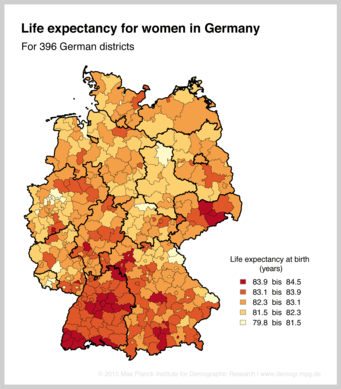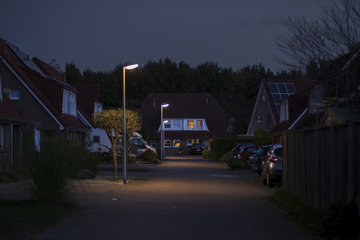East-west divide in life expectancy almost overcome
Regional economic development increasingly important for length of life
Twenty-five years after reunification, the once considerable differences between life expectancy in eastern and western Germany have almost disappeared for women. East German men have also benefited strongly from unification, but they still lag behind western men. Overall, a clear south-north gradient has developed throughout Germany with regard to life expectancy, which often reflects economic development. Individual regions, such as the Ruhr region and Saarland are considerably lagging behind. These are findings of a study in which researchers from the Max Planck Institute for Demographic Research in Rostock carried out a nationwide analysis of the regional trends in life expectancy.

“Life expectancy has increased everywhere and continues to rise everywhere – at present through a gain in years in the second half of life,” says demographer Sebastian Klüsener. “However, the degree to which the regions benefit, differ markedly.” In fact, the gains in the life expectancy of women between 1996 and 2010 vary between six months and over six years. “The biggest increase can be seen in the east,” says MPIDR researcher Rembrandt Scholz. East German women have more or less caught up with those in the West since reunification: in 1996, women in the old German Federal States lived an average of one year longer than women in the new German Federal States (West: 80.2 years; East: 79.0). This gap has now dwindled to just a few months (West: 82.8 years; East: 82.6).
For men, life expectancy in the west is still over one year higher than in the east (2010: West: 78.0 years, East: 76.6). Nevertheless, men in the new Federal States have gained considerable ground. In terms of regions, the biggest winner is the north-east. With gains of around nine percent, the eastern parts of Mecklenburg-Vorpommern and eastern Brandenburg have improved in particular. The administrative district of Rostock leads the field with a gain of six-and-a-half years between 1996 and 2010. Districts like Dahme-Spreewald and Uckermark in Brandenburg have also recorded six-year-plus gains.
Patchwork quilt with south-north gradient
People live longest in the south: At 83.6 years, Baden-Württemberg is the top Federal State for life expectancy in women and is followed by Saxony, Bavaria and Hessen. “But whether a region falls behind has increasingly less to do with east or west, north or south,” says Sebastian Klüsener. In fact, because areas with structural economic problems are also falling behind in the west, the life expectancy map increasingly resembles a patchwork quilt with strong and weak regions scattered throughout Germany.
While the districts with the shortest life expectancy for women in 1996 were in the east, they are now more common in the Ruhr region. “Although these parts of the Ruhr region look small on the map, the sizes of their populations are similar to some of the eastern Federal States,” says demographer Rembrandt Scholz. Saarland, the Federal State at the very bottom of the female life expectancy league, is also in the west.
Economic development as an increasingly important factor in life expectancy
The major east-west divide arose during the GDR period because the health system there lagged behind the system in the Federal Republic. After reunification, together with the differences in medical care and pensions, the large disparities in life expectancy were increasingly consigned to the past. “Today, it is the highly developed regions throughout Germany that lead the field,” says Rembrandt Scholz. This is also related to migrant flows. “Highly developed regions attract people with a high level of education who live considerably longer.”
“Many studies show that economic development has become an increasingly important factor in relation to the trends in life expectancy in recent decades,” says Sebastian Klüsener. This is the culmination of a 100-year trend which saw the influence of environmental factors and cultural traditions decline. In the past, environmental pollution and unhygienic conditions in highly developed cities and industrial regions resulted in a strong reduction in life expectancy. Thanks to technological progress, these factors have little or no influence today. The same applies to regional differences in breastfeeding habits: Around 1910, it was particularly common in Bavaria to feed babies with flour and water porridge rather than breastfeed them. Because the water used to make the porridge was often infected with pathogens, many newborns died of diarrhoea. This was a major contributory factor to the old north-south divide in life expectancy.
Nonetheless, the north’s leading position in life expectancy in the early twentieth century was already due to economic factors: the northern regions were richer then as they had more flourishing industries and international ports which ensured good access to global markets. In this way, the north was able to benefit earlier from globalization than the south.
For their study, the demographers used, among other resources, historical data from the Statistisches Reichsamt and the birth statistics from official statistics up to the year 2010. In order to be able to compare regions that remained the same over time despite regional reforms, the researchers combined several districts in Mecklenburg-Vorpommern and Sachsen-Anhalt to form larger regions. As a result, they subdivided the regional results into 396 areas rather than the current 402 local and administrative districts. In all cases, the life expectancies are applicable to the time of birth and over a period of three years, or to the middle year of the period (i.e. “for 2010” rather than “for 2009/2011”).
BS/MEZ












